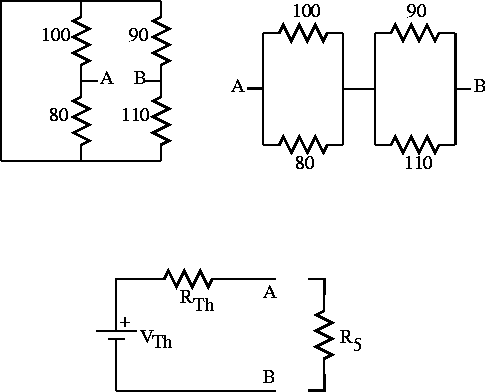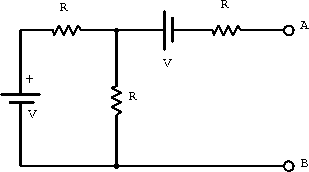One approach to determine the equivalent circuits is:
An alternative to step 2 is to short all voltage sources, open all
current sources, and calculate the equivalent resistance remaining
between A and B.
We will use the latter approach whenever manageable.
To see if you understand equivalent circuits so far, convince yourself
that ![]() .
.
Solution: From Thevenin's theorem

According to Notron's theorem

Therefore


Lets now return to our Wheatstone bridge example shown in
figure 1.6.
We will calculate the current through ![]() by replacing the rest of
the circuit by its Thevenin equivalent.
by replacing the rest of
the circuit by its Thevenin equivalent.
![]()
![]()
![]()
The result is ![]() V.
The minus sign means only that the arbitrary choice of polarity was
incorrect.
V.
The minus sign means only that the arbitrary choice of polarity was
incorrect.

Figure 1.9:
Thevenin's theorem applied to the Wheatstone bridge circuit.
![]()
Note that when the source is shorted out, the resistors that were in
series ( ![]() and
and ![]() ;
; ![]() and
and ![]() ) become parallel combinations.
) become parallel combinations.
![]()
Note that the numerical value of the current is the same as that in
the preceding calculations, but the sign is opposite.
This is simply due to the incorrect choice of polarity of ![]() for this calculation.
In fact, the current flow is in the same direction in both examples,
as would be expected.
for this calculation.
In fact, the current flow is in the same direction in both examples,
as would be expected.
Example: Find the Thevenin equivalent componentsand
for the circuit in figure 1.10.

Figure 1.10: Example circuit for analysis using a Thevenin equivalent circuit.
Shorting the V's to find
gives two resistors in parallel, which are in series with a third resistor:

The open circuit voltage gives
. For the open circuit no current flows from the node joining the two resistors to A. A is thus at -V relative to this node. Around the interior loop
(cf. voltage divider).
Therefore

Narippawaj Ngernvijit